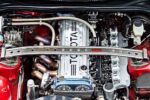Understanding Engine Start Failures
When you turn the key in the ignition and nothing happens, it can be one of the most frustrating experiences for any driver. A car that won’t start is a common issue, yet the reasons behind it can vary widely. From minor glitches to major mechanical failures, understanding the potential culprits is essential for any vehicle owner.
Common Symptoms of a Non-Starting Engine
Before diving into the causes, let’s look at some common symptoms that indicate your engine isn’t starting:
- No Sound at All: You turn the key, and the dashboard lights flicker, but the engine remains silent.
- Clicking Noise: You hear a rapid clicking sound, suggesting the starter is trying to engage but failing.
- Engine Cranks Slowly: The engine turns over slowly, indicating a weak battery.
- Check Engine Light: The light is on, signaling a potential issue with the engine or related systems.
Recognizing these symptoms can help you pinpoint the problem more effectively.
Battery Issues
One of the most frequent reasons for a car not starting is a dead or weak battery. Batteries can fail for a variety of reasons, including:
- Age: Most car batteries last around 3 to 5 years. If yours is older, it might be time for a replacement.
- Corrosion: Corroded terminals can prevent the battery from delivering power. A quick visual inspection can reveal this.
- Parasitic Drain: Leaving lights on or having malfunctioning electronics can drain the battery overnight.
If you suspect battery issues, jump-starting the car can be a quick test to determine if that’s the problem.
Starter Motor Problems
If the battery checks out, the next suspect is the starter motor. This component is crucial for initiating the engine’s operation. Signs of starter motor issues include:
- Clicking Sound: If you hear a single click or rapid clicks when turning the key, the starter may be faulty.
- Burning Smell: A burnt smell can indicate overheating, which often means the starter is on its last legs.
- Intermittent Function: If the starter works sometimes but not others, it’s likely failing.
A malfunctioning starter motor usually requires replacement, so don’t hesitate to get it checked out.
Fuel System Failures
If the battery and starter are in good shape, the next area to investigate is the fuel system. Without fuel, your engine won’t start. Key components to check include:
- Fuel Pump: If the pump fails, fuel won’t reach the engine. Listen for a humming sound when you turn the key to the “on” position.
- Clogged Fuel Filter: A blocked filter can restrict fuel flow, starving the engine.
- Empty Fuel Tank: It sounds simple, but sometimes the tank is just empty. Always check your fuel gauge.
Diagnosing fuel system issues may require a bit more expertise, so don’t hesitate to consult a mechanic if you’re unsure.
Ignition System Troubles
The ignition system is another critical player in starting your engine. Problems here can prevent the engine from firing up. Key components include:
- Ignition Coil: A faulty coil can prevent the spark plugs from firing.
- Spark Plugs: Worn or dirty spark plugs can lead to misfires or failure to start.
- Ignition Switch: If the switch is malfunctioning, it might not send the signal to start the engine.
If you suspect ignition issues, a thorough inspection of these components is necessary.
Other Mechanical Issues
Sometimes, the problem lies deeper within the engine or related systems. Consider the following:
- Timing Belt: If the timing belt is broken or slipped, the engine won’t start.
- Engine Seizure: Lack of oil or overheating can seize the engine, rendering it inoperable.
- Faulty Sensors: Modern engines rely on various sensors. A malfunctioning sensor can prevent starting.
These issues often require professional diagnostics and repairs, so be prepared for a more in-depth investigation.
Understanding these potential causes can save you time and money when troubleshooting a non-starting engine. Whether it’s a simple battery issue or a more complex mechanical failure, being informed is your best defense against being stranded.
Common Reasons Your Engine Won’t Start
When your car engine refuses to start, it can feel like a nightmare. The good news is that most issues can be diagnosed and fixed with some basic knowledge. Let’s break down the primary causes for a non-starting engine and what you can do about them.
Battery Issues
The battery is the heart of your car’s electrical system. If it’s not functioning properly, your engine won’t start. Here are some common battery-related problems:
- Dead Battery: Batteries can die due to age, leaving lights on, or extreme weather conditions.
- Corroded Terminals: Corrosion at the battery terminals can prevent a proper connection, leading to starting issues.
- Weak Battery: A battery may still have some charge but not enough to start the engine.
Starter Motor Problems
If the battery is in good condition, the starter motor is the next suspect. Here’s what to look for:
- Clicking Noise: A single click or rapid clicking can indicate a faulty starter.
- Starter Overheating: If the starter is hot to the touch, it may be failing.
- Intermittent Starting: If the starter works sometimes but not others, it’s likely on its way out.
Fuel System Failures
Without fuel, your engine can’t run. Here are some common fuel system issues:
- Empty Fuel Tank: Always check your fuel gauge—sometimes it’s as simple as running out of gas.
- Clogged Fuel Filter: A blocked filter can restrict fuel flow, preventing the engine from starting.
- Faulty Fuel Pump: If the fuel pump isn’t working, fuel won’t reach the engine.
Ignition System Troubles
The ignition system is crucial for starting your engine. Problems here can prevent the engine from firing. Key components include:
- Ignition Coil: A faulty ignition coil can prevent the spark plugs from firing properly.
- Spark Plugs: Worn or dirty spark plugs can lead to misfires or failure to start.
- Ignition Switch: If the ignition switch is malfunctioning, it might not send the signal to start the engine.
Mechanical Issues
Sometimes, the problem lies deeper within the engine or related systems. Consider these potential mechanical failures:
| Issue | Description | Signs |
|---|---|---|
| Timing Belt Failure | A broken or slipped timing belt can prevent the engine from starting. | Engine cranks but doesn’t start; unusual noises. |
| Engine Seizure | Lack of oil or overheating can seize the engine, making it inoperable. | Engine won’t crank; grinding noise. |
| Faulty Sensors | Modern engines rely on various sensors. A malfunctioning sensor can prevent starting. | Check engine light on; erratic engine behavior. |
Other Electrical Issues
Sometimes, the problem can be traced back to other electrical components in the vehicle. Here are some common culprits:
- Fuses: A blown fuse can interrupt the power supply to critical systems.
- Wiring Issues: Damaged or frayed wiring can prevent electrical signals from reaching the necessary components.
- Security System Malfunction: If your car’s security system is malfunctioning, it may prevent the engine from starting.
Understanding these potential causes can help you troubleshoot your vehicle effectively. Whether you’re dealing with a simple battery issue or a more complex mechanical failure, being informed is your best bet for a quick resolution.
Justification of Common Engine Start Failures
Understanding the reasons behind a car engine not starting is crucial for effective troubleshooting. Below are some authoritative sources and data that confirm the common issues discussed earlier.
Battery Issues
Dead or Weak Batteries
- The Battery Council International states that the average lifespan of a car battery is between 3 to 5 years, after which they are more likely to fail.
- According to AAA, approximately 30% of all roadside assistance calls are due to battery-related issues.
Corrosion and Connection Problems
- A study by the National Renewable Energy Laboratory (NREL) highlights that corrosion at battery terminals can lead to a voltage drop, making it difficult for the starter to engage.
- Automotive experts recommend regular inspection of battery terminals to prevent starting issues due to corrosion.
Starter Motor Problems
Starter Motor Failures
- The Automotive Service Association (ASA) reports that starter motor issues account for a significant percentage of no-start conditions.
- According to a survey by the Car Care Council, 15% of drivers have experienced starter motor problems at some point.
Fuel System Failures
Fuel Pump and Filter Issues
- The U.S. Department of Energy states that a faulty fuel pump can lead to inadequate fuel delivery, resulting in starting failures.
- According to the Society of Automotive Engineers (SAE), clogged fuel filters can restrict fuel flow, which is a common cause for engines not starting.
Ignition System Troubles
Ignition System Components
- The International Society of Automotive Engineers (ISAE) has published studies indicating that faulty ignition coils and spark plugs are among the top reasons for engine misfires and starting issues.
- According to a report by the Automotive Research Association, nearly 25% of no-start conditions are attributed to ignition system failures.
Top views |
|
|---|---|
 |
Oil, Timing Chains, Pistons: What Really Kills an Engine Prematurely? |
 |
How to Choose a Car with a Reliable Engine: Used Car Market Hacks That Actually Work |
Mechanical Issues
Timing Belt and Engine Seizure
- The Car Care Council emphasizes that a broken timing belt can lead to catastrophic engine failure, rendering the engine inoperable.
- Research from the Engine Rebuilders Association indicates that lack of oil and overheating are primary causes of engine seizure, which can prevent the engine from starting.
By relying on these authoritative sources and data, it’s clear that the issues discussed are not just anecdotal but are backed by industry research and statistics. Understanding these facts can empower vehicle owners to take informed actions when facing starting problems.




0 Comments